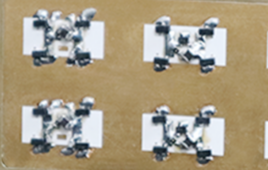Silicon Labs delivers ultra-low-power, long-range wireless connectivity to battery-powered IoT devices with a new LTE-M expansion kit featuring Digi International’s Digi XBee3™ pre-certified cellular modem. The LTE-M expansion kit works with Silicon Labs’ EFM32 Giant Gecko 11 starter kit and simplifies and accelerates the development of gateways and end devices that operate in deep-sleep mode and require extended battery life. The solution is ideal for agricultural, asset tracking, smart energy and smart city IoT applications.
“Together, Silicon Labs and Digi International are dedicated to connecting people, networks and ‘things’ with best-in-class IoT and M2M technologies,” said Matt Johnson, Senior Vice President and General Manager of IoT products at Silicon Labs. “We’ve collaborated with Digi to deliver flexible LTE-M cellular connectivity capabilities, enabling cloud-connected applications that are remote, on the go and ready to deploy.”
“The jointly developed LTE-M expansion kit works with Silicon Labs’ starter kits to accelerate development by quickly enabling cellular IoT connectivity and avoiding costly cellular device certifications,” said Mark Tekippe, Director of Product Management, Digi International. “Digi XBee3 cellular modems and Silicon Labs Gecko MCUs are an ideal pairing to deliver seamless cloud connectivity with ultra-low power capabilities. The pre-certified Digi XBee3 cellular modem is easy to configure and provides secure, flexible out-of-box connectivity over LTE-M and NB-IoT networks.”
“LTE-M is a great option for LPWAN applications that require a combination of long battery life, LTE reliability and low latency. LTE-M is compatible with existing LTE networks and in the future will coexist with 5G technologies,” added Mike Krell, Head of IoT Strategy, J. Brehm & Associates. “Vendors offering easy-to-use development tools to accelerate LTE-M solutions will be well-positioned for growth in the cellular IoT market.”
Developers can take advantage of the LTE-M expansion kit’s advanced development tools including the Digi Remote Manager®, Silicon Labs’ Energy Profiler and pre-programmed demos to rapidly deliver optimized LTE-M products. Digi XBee3 modems certified on AT&T and Verizon cellular networks, combined with energy-friendly EFM32 microcontrollers (MCUs), provide developers with a mobile IoT development toolkit to deliver advanced, low-power wide-area network (LPWAN) connectivity.
Flexibility and Simplicity, All in One Kit
- FCC certified and carrier end-device certified Digi XBee3 LTE-M modem
- Ready-to-use kit development tools and demos with Giant Gecko 11 MCU starter kit
- Common Digi XBee® family for easy migration to NB-IoT
- Digi XBee API frames, MicroPython and XCTU® software tools to simplify development
- Digi TrustFence® integrated device security, identity and data privacy
- Digi Remote Manager® for over-the-air device configuration and firmware updates
- MCU host examples easily migrated from Giant Gecko 11 to other Silicon Labs low-power EFM32 MCUs and EFR32 Wireless Gecko SoCs and modules
Pricing and Availability
Silicon Labs’ LTE-M expansion kit and EFM32 Giant Gecko 11 starter kit (SLSTK3701A) are available now, and both are priced at $99 (USD MSRP). The SLSTK3701A kit provides an excellent starting point to get familiar with Giant Gecko MCUs. To learn more about the LTE-M expansion kit and Giant Gecko starter kit, visit silabs.com/lte-m.
![]()



